Abstract
Five commercially available immunoassays were evaluated for the detection of Chlamydia psittaci in cloacal and conjunctival swabs from industrially raised turkeys: IMAGEN (DAKO Diagnostics, Ely, Cambridgeshire, United Kingdom), Chlamydia CEL-VET IF (Cellabs, Brookvale, Australia), IDEIA (DAKO Diagnostics), CELISA (Cellabs), and CLEARVIEW (Unipath, Bedford, United Kingdom). Results were compared with isolation in Buffalo Green Monkey cells as a reference method. For the conjunctival samples, the sensitivities of the IMAGEN test, the Chlamydia CEL-VET IF test, the IDEIA, the CELISA, and the CLEARVIEW test were found to be 100, 66, 0, 0, and 0%, respectively, as compared to the reference test. Also for the conjunctival samples, the specificities of the IMAGEN test, the Chlamydia CEL-VET IF test, and the IDEIA were found to be 100, 11, and 92.8%, respectively. For the cloacal specimens, the sensitivities of the IMAGEN test, the Chlamydia CEL-VET IF test, the IDEIA, the CELISA, and the CLEARVIEW test were found to be 100, 93.3, 26.6, 0, and 53.3%, respectively. Also for the cloacal specimens, the specificities of the IMAGEN test, the Chlamydia CEL-VET IF test, the IDEIA, and the CLEARVIEW test were found to be 92, 12, 100, and 88%, respectively. The IMAGEN test was the most sensitive and specific direct chlamydia antigen detection test for cloacal and conjunctival samples from turkeys.
Full text
PDF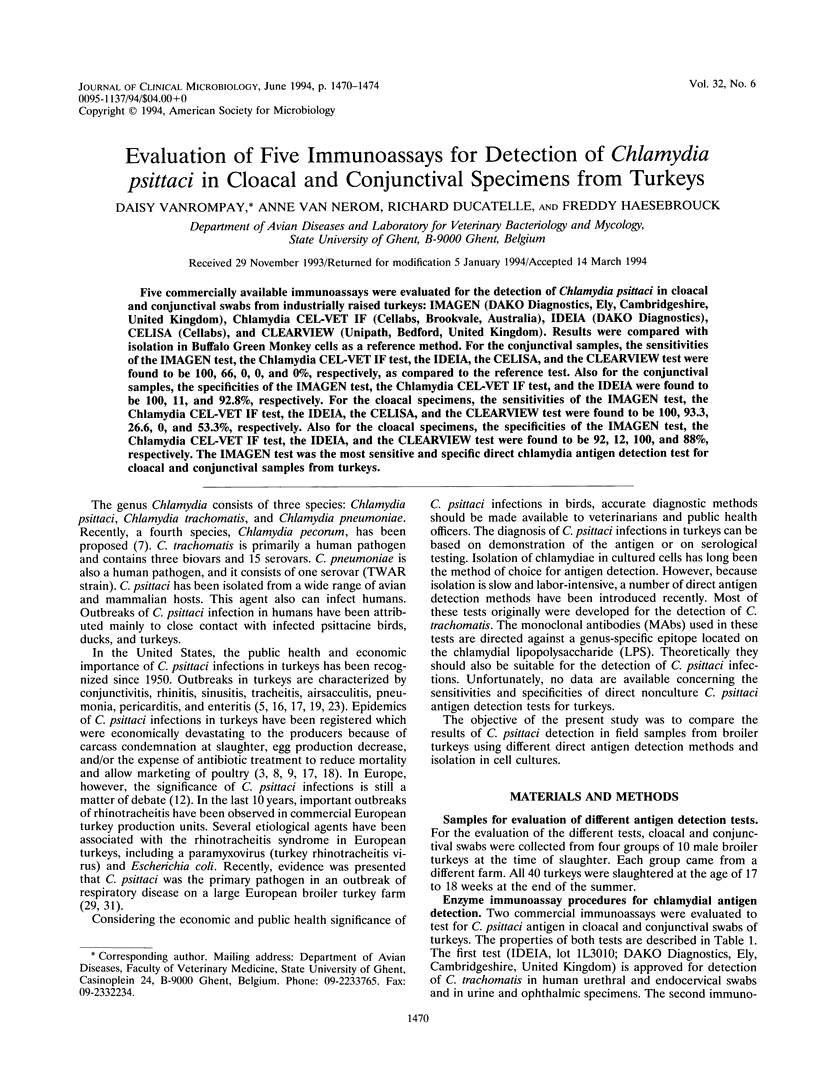
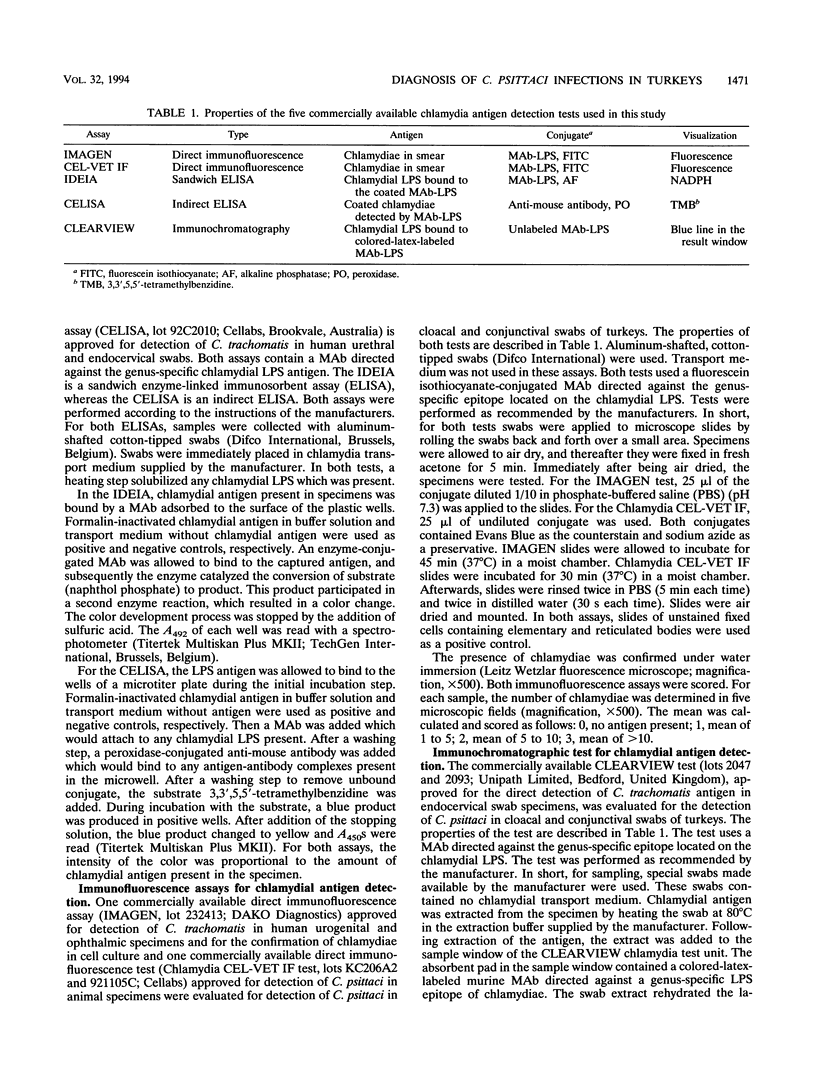
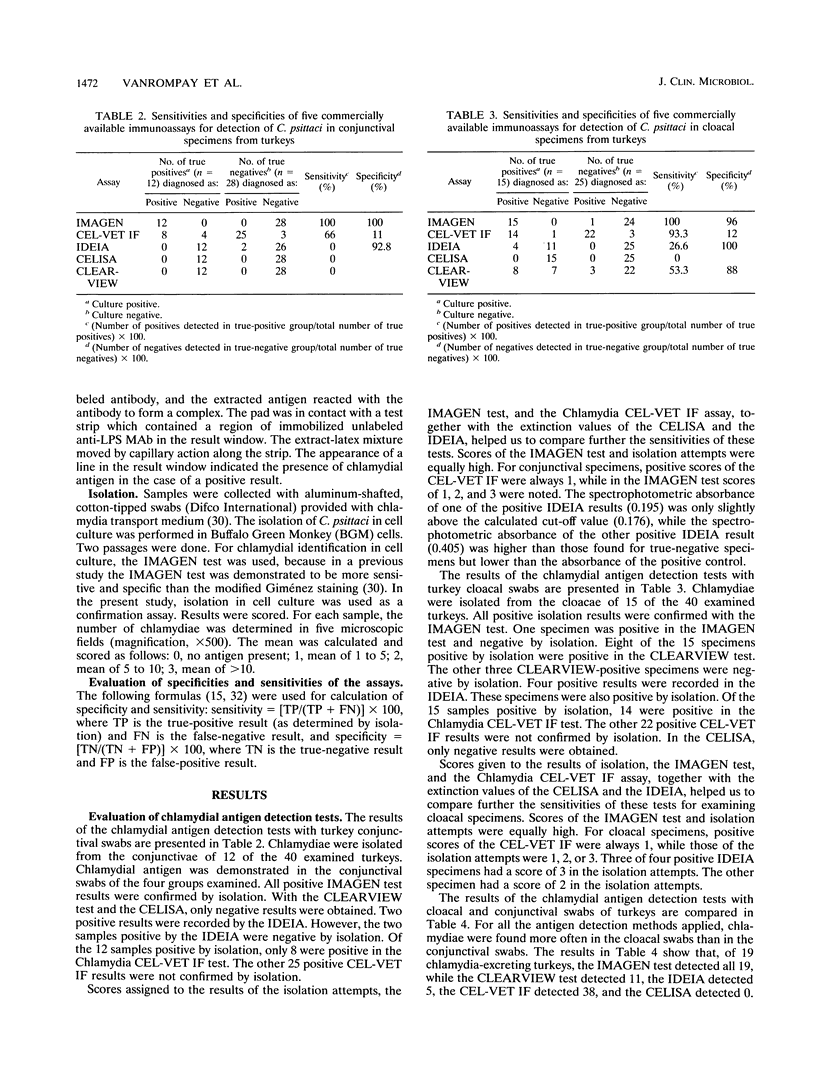
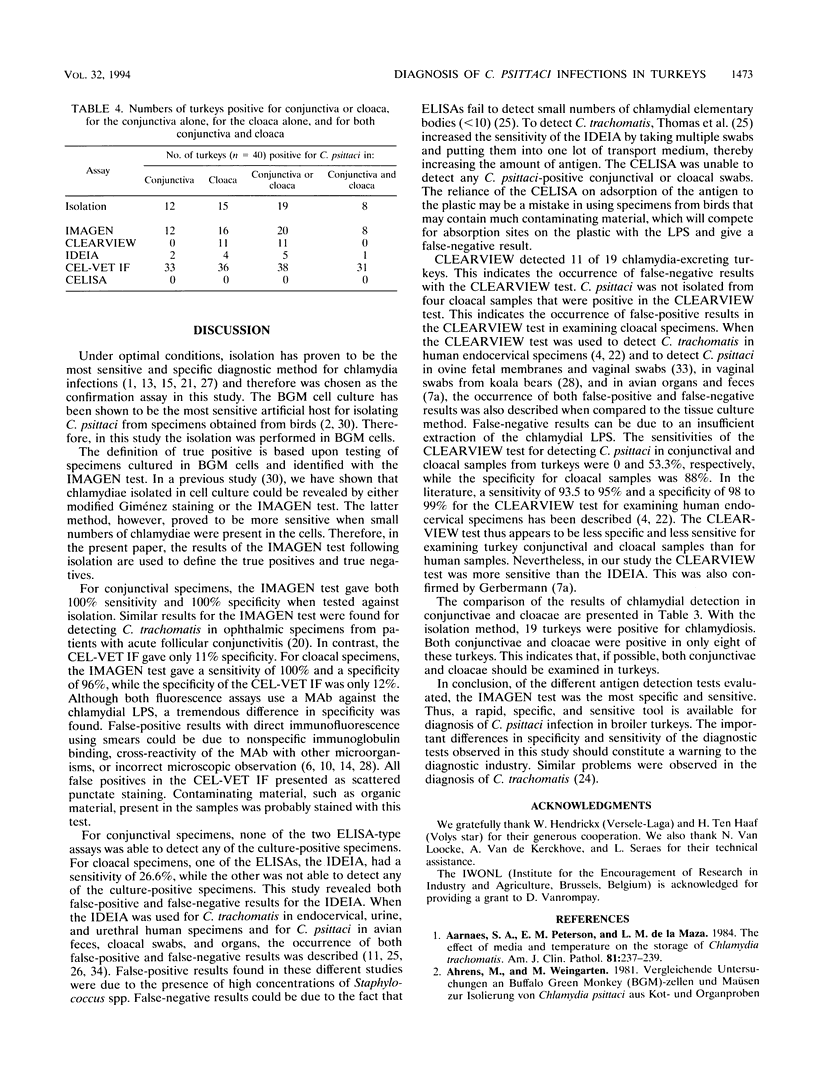
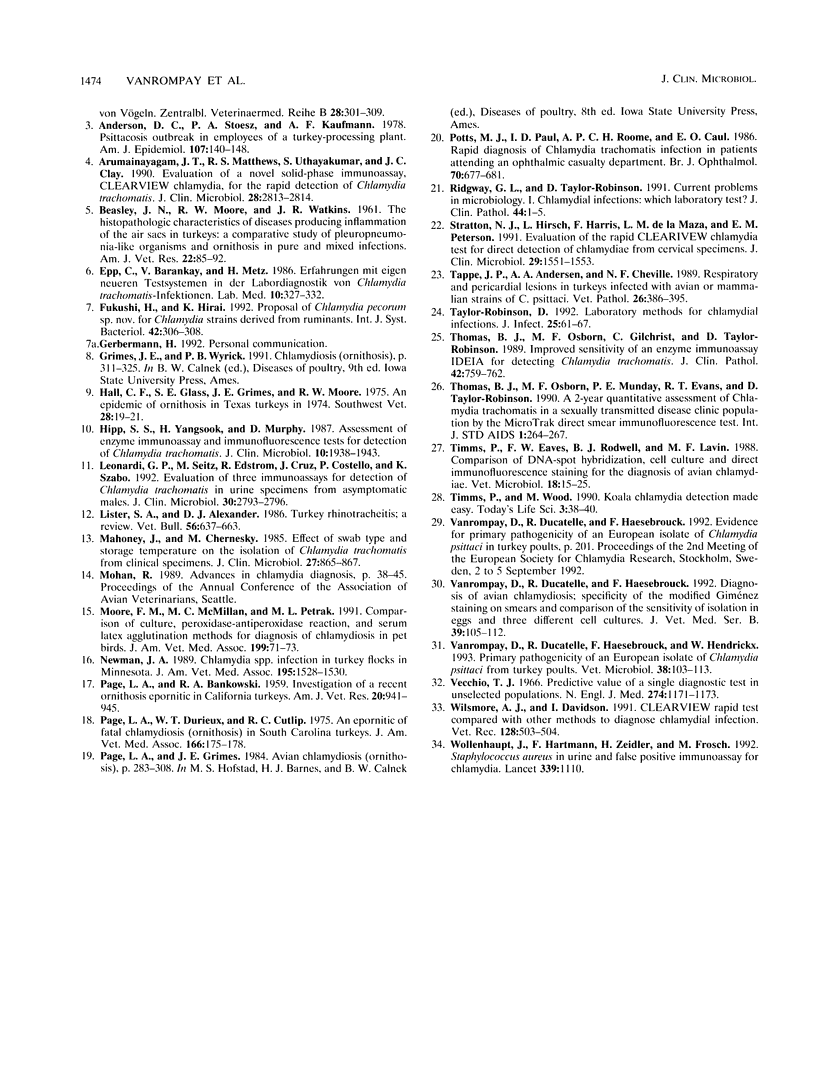
Selected References
These references are in PubMed. This may not be the complete list of references from this article.
- Aarnaes S. L., Peterson E. M., De La Maza L. M. The effect of media and temperature on the storage of Chlamydia trachomatis. Am J Clin Pathol. 1984 Feb;81(2):237–239. doi: 10.1093/ajcp/81.2.237. [DOI] [PubMed] [Google Scholar]
- Anderson D. C., Stoesz P. A., Kaufmann A. F. Psittacosis outbreak in employees of a turkey-processing plant. Am J Epidemiol. 1978 Feb;107(2):140–148. doi: 10.1093/oxfordjournals.aje.a112516. [DOI] [PubMed] [Google Scholar]
- Arumainayagam J. T., Matthews R. S., Uthayakumar S., Clay J. C. Evaluation of a novel solid-phase immunoassay, Clearview Chlamydia, for the rapid detection of Chlamydia trachomatis. J Clin Microbiol. 1990 Dec;28(12):2813–2814. doi: 10.1128/jcm.28.12.2813-2814.1990. [DOI] [PMC free article] [PubMed] [Google Scholar]
- BEASLEY J. N., MOORE R. W., WATKINS J. R. The histopathologic characteristics of diseases producing inflammation of the air sacs in turkeys. A comparative study of pleuropneumonia-like organisms and ornithosis in pure and mixed infections. Am J Vet Res. 1961 Jan;22:85–92. [PubMed] [Google Scholar]
- Fukushi H., Hirai K. Proposal of Chlamydia pecorum sp. nov. for Chlamydia strains derived from ruminants. Int J Syst Bacteriol. 1992 Apr;42(2):306–308. doi: 10.1099/00207713-42-2-306. [DOI] [PubMed] [Google Scholar]
- Hipp S. S., Han Y., Murphy D. Assessment of enzyme immunoassay and immunofluorescence tests for detection of Chlamydia trachomatis. J Clin Microbiol. 1987 Oct;25(10):1938–1943. doi: 10.1128/jcm.25.10.1938-1943.1987. [DOI] [PMC free article] [PubMed] [Google Scholar]
- Leonardi G. P., Seitz M., Edstrom R., Cruz J., Costello P., Szabo K. Evaluation of three immunoassays for detection of Chlamydia trachomatis in urine specimens from asymptomatic males. J Clin Microbiol. 1992 Nov;30(11):2793–2796. doi: 10.1128/jcm.30.11.2793-2796.1992. [DOI] [PMC free article] [PubMed] [Google Scholar]
- Mahony J. B., Chernesky M. A. Effect of swab type and storage temperature on the isolation of Chlamydia trachomatis from clinical specimens. J Clin Microbiol. 1985 Nov;22(5):865–867. doi: 10.1128/jcm.22.5.865-867.1985. [DOI] [PMC free article] [PubMed] [Google Scholar]
- Moore F. M., McMillan M. C., Petrak M. L. Comparison of culture, peroxidase-antiperoxidase reaction, and serum latex agglutination methods for diagnosis of chlamydiosis in pet birds. J Am Vet Med Assoc. 1991 Jul 1;199(1):71–73. [PubMed] [Google Scholar]
- Newman J. A. Chlamydia spp infection in turkey flocks in Minnesota. J Am Vet Med Assoc. 1989 Dec 1;195(11):1528–1530. [PubMed] [Google Scholar]
- Page L. A., Derieux W. T., Cutlip R. C. An epornitic of fatal chlamydiosis (ornithosis) in South Carolina turkeys. J Am Vet Med Assoc. 1975 Jan 15;166(2):175–178. [PubMed] [Google Scholar]
- Potts M. J., Paul I. D., Roome A. P., Caul E. O. Rapid diagnosis of Chlamydia trachomatis infection in patients attending an ophthalmic casualty department. Br J Ophthalmol. 1986 Sep;70(9):677–680. doi: 10.1136/bjo.70.9.677. [DOI] [PMC free article] [PubMed] [Google Scholar]
- Ridgway G. L., Taylor-Robinson D. Current problems in microbiology: 1. Chlamydial infections: which laboratory test? J Clin Pathol. 1991 Jan;44(1):1–5. doi: 10.1136/jcp.44.1.1. [DOI] [PMC free article] [PubMed] [Google Scholar]
- Stratton N. J., Hirsch L., Harris F., de la Maza L. M., Peterson E. M. Evaluation of the rapid CLEARVIEW Chlamydia test for direct detection of chlamydiae from cervical specimens. J Clin Microbiol. 1991 Jul;29(7):1551–1553. doi: 10.1128/jcm.29.7.1551-1553.1991. [DOI] [PMC free article] [PubMed] [Google Scholar]
- Tappe J. P., Andersen A. A., Cheville N. F. Respiratory and pericardial lesions in turkeys infected with avian or mammalian strains of Chlamydia psittaci. Vet Pathol. 1989 Sep;26(5):386–395. doi: 10.1177/030098588902600504. [DOI] [PubMed] [Google Scholar]
- Taylor-Robinson D. Laboratory methods for chlamydial infections. J Infect. 1992 Jul;25 (Suppl 1):61–67. doi: 10.1016/0163-4453(92)92068-t. [DOI] [PubMed] [Google Scholar]
- Thomas B. J., Osborn M. F., Gilchrist C., Taylor-Robinson D. Improved sensitivity of an enzyme immunoassay IDEIA for detecting Chlamydia trachomatis. J Clin Pathol. 1989 Jul;42(7):759–762. doi: 10.1136/jcp.42.7.759. [DOI] [PMC free article] [PubMed] [Google Scholar]
- Thomas B. J., Osborn M. F., Munday P. E., Evans R. T., Taylor-Robinson D. A 2-year quantitative assessment of Chlamydia trachomatis in a sexually transmitted diseases clinic population by the MicroTrak direct smear immunofluorescence test. Int J STD AIDS. 1990 Jul;1(4):264–267. doi: 10.1177/095646249000100407. [DOI] [PubMed] [Google Scholar]
- Timms P., Eaves F. W., Rodwell B. J., Lavin M. F. Comparison of DNA-spot hybridization, cell culture and direct immunofluorescence staining for the diagnosis of avian chlamydiae. Vet Microbiol. 1988 Sep;18(1):15–25. doi: 10.1016/0378-1135(88)90112-5. [DOI] [PubMed] [Google Scholar]
- Vanrompay D., Ducatelle R., Haesebrouck F. Diagnosis of avian chlamydiosis: specificity of the modified Giménez staining on smears and comparison of the sensitivity of isolation in eggs and three different cell cultures. Zentralbl Veterinarmed B. 1992 Mar;39(2):105–112. doi: 10.1111/j.1439-0450.1992.tb01144.x. [DOI] [PubMed] [Google Scholar]
- Vanrompay D., Ducatelle R., Haesebrouck F., Hendrickx W. Primary pathogenicity of an European isolate of Chlamydia psittaci from turkey poults. Vet Microbiol. 1993 Dec;38(1-2):103–113. doi: 10.1016/0378-1135(93)90078-l. [DOI] [PubMed] [Google Scholar]
- Vecchio T. J. Predictive value of a single diagnostic test in unselected populations. N Engl J Med. 1966 May 26;274(21):1171–1173. doi: 10.1056/NEJM196605262742104. [DOI] [PubMed] [Google Scholar]
- Wilsmore A. J., Davidson I. 'Clearview' rapid test compared with other methods to diagnose chlamydial infection. Vet Rec. 1991 May 25;128(21):503–504. doi: 10.1136/vr.128.21.503. [DOI] [PubMed] [Google Scholar]


